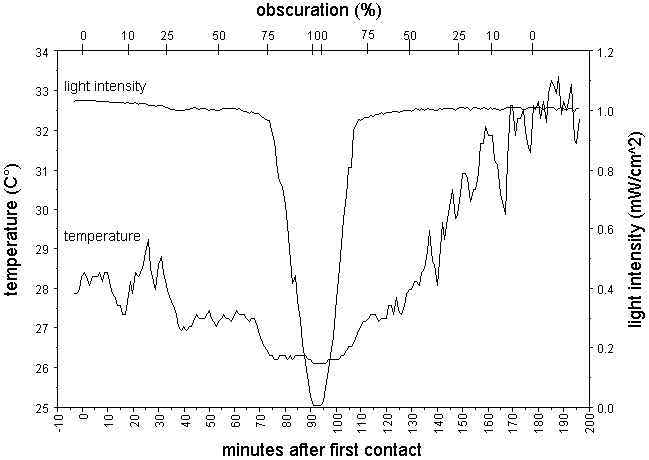
ESOP XVIII Homepage |
Letzte
Änderung: 01.11.1999 |
Simple Experiments for Students During a Total Solar Eclipse
James R. Huddle
Eine günstige Gelegenheit für den wissenschaftlichen
Unterricht bieten totale Sonnnenfinsternisse.
Am Beispiel der Finsternis in Aruba 1998 werden sechs Experimente vorgeführt.
Solar eclipses present an exciting opportunity to teach students about science. During the 1998 total eclipse in Aruba, four students and two physics professors performed six experiments. The youngest student was aged 12 years, and the oldest were seniors in college.
In this lecture, we will give a brief description of the analysis of a videotaped image of the flash spectrum and one of a measurement of the ambient light and temperature using an inexpensive Calculator Based Laboratory (CBL) instrument driven by a programmable graphing calculator. Even more briefly, we will mention video records of the contacts, of the shadow bands and of polarization in the corona. We will conclude with a very brief remark about the behavior of flamingoes and iguanas during the eclipse.

Fig. 1. Ambient air temperature and light intensity as a
function of time during the total solar eclipse of 26 February 1998 as measured
at Sonesta Island, Aruba.
The percent obscurations indicated on the top axis were calculated by F. Espenak.
Prof. Dr. James R. Huddle, Associate Professor, United
States Naval Academy, Annapolis, Maryland 21402-5026, USA
Address: Physics Department, U. S. Naval Academy, 572 Holloway Road, Annapolis,
MD 21402-5026, U.S.A.
E-Mail: huddle@nadn.navy.mil Telephon: +1 410 293 6672 Fax: +1 410 293 3729
 Last
update: 1999 NOV 01.
Last
update: 1999 NOV 01.(c) 1998-2000
Schwäbische
Sternwarte e.V. Stuttgart - All rights reserved
Bei Problemen: webmaster@sternwarte.de